Methodology Applied to the Evaluation of Natural Ventilation in Residential Building Retrofits: A Case Study
Abstract
:1. Introduction
2. Area of Interest
- Type 1: A structured urban area to the east of the development, with residential blocks of five and six stories, separated by urban corridors.
- Type 2: A low-density and low-height environment combined with green spaces.
- Type 3: A medium-density area with alternating blocks of two- and three-story buildings and attached single family units.
- Type 4: A rural environment, with limited wooded areas and a lake that lends its name to the town.
3. Methodology
- Gravity for calculations (41°34′59″ N and 704 m a.s.l.) is = 9.80094 m/s2.
- Reference atmospheric pressure ( = 11.4 °C) is pa = 93,049 Pa.
- Density values ρext, ρo and ρint (from exterior, unconditioned, and interior spaces) [18] correspond to mean outdoor conditions for calculations (January ‘mean temperature’ Text = 3.0 °C/‘relative humidity’ RH = 85.3%, July Text = 20.5 °C/RH = 46.9%, and ‘annual mean temperature’ Text = 11.4 °C/RH = 65% [19]) in combination with other indoor comfort values for apartments (‘Dry-bulb temperature’ Tint = 23.0 °C/RH = 50%) and unconditioned spaces (winter To = 7.0 °C/RH = 65%, summer To = 21 °C/RH = 46%, and annual To = 13.7 °C/RH = 57%).
- The predominant wind pattern at the regional level is the so-called ‘Ábrego’, coming from the West-South West. To obtain a specific wind profile for the location, the national wind atlas [20] is used and includes a wind rose at a height of 80 m (Figure 4). The mean seasonal velocity at this height is 5.30 m/s in the winter, 4.55 m/s in the summer and 5.02 m/s annually. The predominant directions West-South West/South West and North East hit the blocks orthogonally.
3.1. Thermal Pressures
3.2. Wind Pressures
3.3. Combined Thermal and Wind Effects
3.4. Permeability of Enclosures
- Apartments are separated from other apartments on the same floor using medium-heavy enclosures, without sharing common elements that interrupt that continuity.
- The test uses the access door to the apartment as a place to locate the ventilator, which translates into the virtual sealing of this weak point separating the apartment from common areas of the building.
- Plumbing is installed inside of the apartment without going through the enclosure. Vertical lines use independent shafts.
- Sealing all framed openings and identified infiltration points resulted in tests with practically no rate of infiltration through the rest of the enclosure.
3.5. Natural Ventilation Flow Rate
4. Results
4.1. Thermal Pressures
4.2. Wind Pressures
4.2.1. Results in an Isolated Block
4.2.2. Urban Model Results
4.3. Combined Results
5. Discussion
- The refurbishment of bathrooms and kitchens has obstructed some or in some cases all vertical ducts for ventilation. The term allows simulation of these changes, calculating the influence of the existence of these ducts in the available natural ventilation flow.
- The replacement of windows affects two different parameters: transmittance, and air permeability. When referred to natural ventilation, the flows are drastically reduced in new windows, which may provoke the need to install additional ventilation openings.
6. Conclusions
- (1)
- Official climatic data, stabilized in time, are used.
- (2)
- CFD configuration validated through wind tunnel experimentation data, making them secure for late wind simulation on urban developments in stationary conditions.
- (3)
- The combination of wind and thermal pressures, being these dependent on temperature conditions, provide the total gradient over each of the envelope surfaces, according to its height and orientation.
- (4)
- Envelope permeability experimentally determined on site with pressurization tests.
- (5)
- Consequently, pressure equilibrium equations consider all the possible factors, solving for the resultant interior pressure and the available flow on the system.
- (6)
- Finally, by varying singular parameters on the equation, it is also possible to quantify their influence on the final considered value.
Acknowledgments
Author Contributions
Conflicts of Interest
References
- Etheridge, D. Natural Ventilation of Buildings; John Wiley & Sons Ltd.: Chichester, UK, 2012. [Google Scholar]
- Chiu, Y.-H. Development of Unsteady Design Procedures of Natural Ventilation Stacks. Ph.D. Thesis, University of Nottingham, Nottingham, UK, 2004. [Google Scholar]
- Turner, W.J.N.; Awbi, H.B. Experimental investigation into the thermal performance of a residential hybrid ventilation system. Appl. Therm. Eng. 2015, 77, 142–152. [Google Scholar] [CrossRef]
- Tong, Z.; Chen, Y.; Malkawi, A.; Liu, Z.; Freeman, R.B. Energy saving potential of natural ventilation in China: The impact of ambient air pollution. Appl. Energy 2016, 179, 660–668. [Google Scholar] [CrossRef]
- Majcen, D.; Itard, L.; Visscher, H. Actual heating energy savings in thermally renovated Dutch dwellings. Energy Policy 2016, 97, 82–92. [Google Scholar] [CrossRef]
- Pisello, A.L.; Castaldo, V.L.; Taylor, J.E.; Cotana, F. The impact of natural ventilation on building energy requirement at inter-building scale. Energy Build. 2016, 127, 870–883. [Google Scholar] [CrossRef]
- Sorgato, M.J.; Melo, A.P.; Lamberts, R. The effect of window opening ventilation control on residential building energy consumption. Energy Build. 2016, 133, 1–13. [Google Scholar] [CrossRef]
- Kinnane, O.; Sinnott, D.; Turner, W.J.N. Evaluation of passive ventilation provision in domestic housing retrofit. Build. Environ. 2016, 106, 205–218. [Google Scholar] [CrossRef]
- Huang, K.-T.; Hwang, R.-L. Parametric study on energy and thermal performance of school buildings with natural ventilation, hybrid ventilation and air conditioning. Indoor Built Environ. 2016, 25, 1148–1162. [Google Scholar] [CrossRef]
- Pabiou, H.; Salort, J.; Ménézo, C.; Chillà, F. Natural cross-ventilation of buildings, an experimental study. Energy Procedia 2015, 78, 2911–2916. [Google Scholar] [CrossRef]
- Budiakova, M. Architectural design of university schoolrooms with the link to ventilation. Proceedings of World Multidisciplinary Civil Engineering-Architecture-Urban Planning Symposium 2016, WMCAUS 2016, Prague, Czech Republic, 13–17 June 2016. [Google Scholar]
- Shen, C.; Li, X. Thermal performance of double skin facade with built-in pipes utilizing evaporative cooling water in cooling season. Sol. Energy 2016, 137, 55–65. [Google Scholar] [CrossRef]
- Sim, J.K.; Cho, Y.-H. Portable sweat rate sensors integrated with air ventilation actuators. Sens. Actuators B Chem. 2016, 234, 176–183. [Google Scholar] [CrossRef]
- Nejat, P.; Calautit, J.K.; Majid, M.Z.A.; Hughes, B.R.; Jomehzadeh, F. Anti-short-circuit device: A new solution for short-circuiting in windcatcher and improvement of natural ventilation performance. Build. Environ. 2016, 105, 24–39. [Google Scholar] [CrossRef]
- CITyFIED Project. Available online: http://es.cityfied.eu/ (accessed on 21 March 2017).
- Meiss, A.; Feijó-Muñoz, J.; Padilla-Marcos, M.A.; Vasallo, A.; Méndez, E. D2.5: Methodology for Natural Processes Based on the Ventilation Systems Evaluation and Implementation; CITyFIED Project; Fundación CARTIF: Valladolid, Spain, 2015. [Google Scholar]
- Li, J.; Ward, I.C. Developing computational fluid dynamics conditions for urban natural ventilation study. In Proceedings of the IBPSA Proceedings: Building Simulation, Beijing, China, 3–6 September 2007. [Google Scholar]
- Davis, R.S. Equation for the determination of the density of moist air (1981/91). Metrologia 1992, 29, 67–70. [Google Scholar] [CrossRef]
- Instituto para la Diversificación y Ahorro de la Energía. Guía técnica de Condiciones Climáticas Exteriores de Proyecto; IDAE: Madrid, Spain, 2010. (In Spanish) [Google Scholar]
- Instituto para la Diversificación y Ahorro de la Energía Atlas eólico de España. Atlas eólico de España. Available online: http://atlaseolico.idae.es/meteosim/ (accessed on 21 March 2017). (In Spanish).
- Yang, W.; Gao, N. The Transport of gaseous pollutants due to stack effect in high-rise residential buildings. Int. J. Vent. 2015, 14, 191–208. [Google Scholar] [CrossRef]
- Jo, J.; Lim, J.; Song, S.; Yeo, M.; Kim, K. Characteristics of pressure distribution and solution to the problems caused by stack effect in high-rise residential buildings. Build. Environ. 2007, 42, 263–277. [Google Scholar] [CrossRef]
- Khoukhi, M.; Al-Maqbali, A. Stack pressure and airflow movement in high and medium rise buildings. Energy Procedia 2011, 6, 422–431. [Google Scholar] [CrossRef]
- Hussain, M.; Lee, B.M. An Investigation of Wind Forces on Three Dimensional Roughness Elements in a Simulated Atmospheric Boundary Layer; Report BS 55; Department of Building Science, University of Sheffield: Sheffield, UK, 1980. [Google Scholar]
- Sutton, O.G. Atmospheric turbulence. Q. J. R. Meteorol. Soc. 1949, 76, 108. [Google Scholar]
- Amorim, J.H.; Rodrigues, V.; Tavares, R.; Valente, J.; Borrego, C. CFD modelling of the aerodynamic effect of trees on urban air pollution dispersion. Sci. Total Environ. 2013, 461, 541–551. [Google Scholar] [CrossRef] [PubMed]
- Fluent Inc. FLUENT 6.1 User’s Guide; Fluent Inc.: Lebanon, NH, USA, 2003. [Google Scholar]
- Launder, B.E.; Spalding, D.B. The numerical computation of turbulent flows. Comput. Methods Appl. Mech. Eng. 1974, 3, 269–289. [Google Scholar] [CrossRef]
- Sutton, O.G. The logarithmic law of wind structure near the ground. Q. J. R. Meteorol. Soc. 1936, 62, 124–127. [Google Scholar] [CrossRef]
- Richards, P.J.; Hoxey, R.P. Appropriate boundary conditions for computational wind engineering models using the k-ε turbulence model. J. Wind Eng. Ind. Aerodyn. 1993, 46, 145–153. [Google Scholar] [CrossRef]
- Hotchkiss, R.S.; Harlow, F.H. Air Pollution Transport in Street Canyons; United States Environmental Protection Agency Report EPA-R4-73-029; Environmental Protection Agency: Washington, DC, USA, 1973.
- Franke, J.; Hellsten, A.; Schlünzen, H.; Carissimo, B. Best Practice Guideline for the CFD Simulation of Flows in the Urban Environment; COST Action 732: Hamburg, Germany, 2007. [Google Scholar]
- Padilla-Marcos, M.A.; Feijó-Muñoz, J.; Meiss, A. Wind velocity effects on the quality and efficiency of ventilation in the modelling of outdoor spaces. Case studies. Build. Serv. Eng. Res. Technol 2016, 37, 33–50. [Google Scholar] [CrossRef]
- Sharples, S.; Bensalem, R. Airflow in courtyard and atrium buildings in the urban environment: A wind tunnel study. Sol. Energy 2001, 70, 237–244. [Google Scholar] [CrossRef]
- Leitl, B.; Schatzmann, M. Validation Data for Microscale Dispersion Modelling; EUROTRAC Newsletter 22; EUROTRAC: Göteborg, Sweden, 2000. [Google Scholar]
- Yakhot, V.; Orszag, S.A.; Thangam, S.; Gatski, T.B.; Speziale, C.G. Development of turbulence models for shear flows by a double expansion technique. Phys. Fluids 1992, 4, 1510–1520. [Google Scholar] [CrossRef]
- Shih, T.H.; Liou, W.W.; Shabbir, A.; Yang, Z.; Zhu, J. A New K-epsilon Eddy Viscosity Model for High Reynolds Number Turbulent Flows: Model Development and Validation. Comput. Fluids 1995, 24, 227–238. [Google Scholar] [CrossRef]
- Kim, J.J.; Baik, J.J. A numerical study of the effects of ambient wind direction on flow and dispersion in urban street canyons using the RNG k-epsilon turbulence model. Atmos. Environ. 2004, 38, 3039–3048. [Google Scholar] [CrossRef]
- Hertwig, D.; Efthimiou, G.C.; Bartzis, J.G.; Leitl, B. CFD-RANS model validation of turbulent flow in a semi-idealized urban canopy. J. Wind Eng. Ind. Aerodyn. 2012, 111, 61–72. [Google Scholar] [CrossRef]
- Micallef, D.; Buhagiar, V.; Borg, S.P. Cross-ventilation of a room in a courtyard building. Energy Build. 2016, 133, 658–669. [Google Scholar] [CrossRef]
- Comité Européen de Normalisation. EN 13829 Thermal Performance of Buildings. Determination of Air PERmeability of Buildings. Fan Pressurization Method; ISO 9972:1996, Modified; Comité Européen de Normalisation: Brussels, Belgium, 2002. [Google Scholar]
- Sherman, M.H.; Chan, W.R. Building air tightness: Research and practice. In Building Ventilation: The State of the Art; Santamouris, M., Wouters, P., Eds.; Routledge: Oxford, UK, 2006; pp. 137–162. [Google Scholar]
- Robertson, J.A. Effect of Building Airtightness and Fan Size on the Performance of Mechanical Ventilation Systems in New U.S. Houses: A Critique of ASHRAE Standard 62.2-2003. Master’s Thesis, University of California, Berkeley, CA, USA, 2004. [Google Scholar]
- Comité Européen de Normalisation. EN 13465:2004 Calculation Methods to Obtain Air Flow Rate in Apartments; Comité Européen de Normalisation: Brussels, Belgium, 2004. [Google Scholar]
- Meiss, A.; Feijo-Muñoz, J.; Padilla-Marcos, M.A. Evaluación, diseño y propuestas de sistemas de ventilación en la rehabilitación de edificios residenciales españoles. Estudio de caso. Inf. Constr. 2016, 68, e148. (In Spanish) [Google Scholar] [CrossRef]
- Gavanski, E.; Uematsu, Y. Local wind pressures acting on walls of low-rise buildings and comparisons to the Japanese and US wind loading provisions. J. Wind Eng. Ind. Aerodyn. 2014, 132, 77–91. [Google Scholar] [CrossRef]
- Rosa, L.; Tomasini, G.; Zasso, A.; Aly, A.M. Wind-induced dynamics and loads in a prismatic slender building: A modal approach based on unsteady pressure measurements. J. Wind Eng. Ind. Aerodyn. 2012, 107, 118–130. [Google Scholar] [CrossRef]
- Moonen, P.; Dorer, V.; Carmeliet, J. Effect of flow unsteadiness on the mean wind flow pattern in an idealized urban environment. J. Wind Eng. Ind. Aerodyn. 2012, 104, 389–396. [Google Scholar] [CrossRef]
- Blocken, B.; Carmellet, J.; Stathopoulos, T. CFD evaluation of wind speed conditions in passages between parallel buildings—Effect of wall-function roughness modifications for the atmospheric boundary layer flow. J. Wind Eng. Ind. Aerodyn. 2007, 95, 941–962. [Google Scholar] [CrossRef]
- Moonen, P.; Dorer, V.; Carmeliet, J. Evaluation of the ventilation potential of courtyards and urban street canyons using RANS and LES. J. Wind Eng. Ind. Aerodyn. 2011, 99, 414–423. [Google Scholar] [CrossRef]
- Tong, Z.; Chen, Y.; Malkawi, A. Defining the Influence Region in neighborhood-scale CFD simulations for natural ventilation design. Appl. Energy 2016, 182, 625–633. [Google Scholar] [CrossRef]
- Ministerio de Fomento. Gobierno de España. Código Técnico de la Edificación. Calidad del aire interior (DB HS-3). RD314/2006. Available online: http://www.codigotecnico.org/images/stories/pdf/salubridad/DBHS.pdf (accessed on 21 March 2017). (In Spanish).
- ASHRAE. Fundamental Handbook, Ch.26.10, Natural Ventilation; American Society of Heating, Refrigeration and Air Conditioning Engineers (ASHRAE): Atlanta, GA, USA, 2001. [Google Scholar]
- Chandra, S.; Farinley, P.W.; Houston, M.M. A handbook for Designing Ventilated Buildings. Florida Solar Energy Centre, Final Report; Florida Solar Energy Centre: Cape Canaveral, FL, USA, 1983. [Google Scholar]
- Givoni, B. Man, Climate and Architecture, 2nd ed.; Elsevier: New York, NY, USA, 1976. [Google Scholar]
- Centre Scientifique et Tecnique du Batiment. Guide sur la climatisasione naturelle de l’habitat et climat tropical humide—Methodologie de prise en compte des parameters climatiques dans l’habitat et conseil pratiques, Tome 1; CSTB: Marne-la-Vallée, France, 1992. (In French) [Google Scholar]
- Ernest, D.R. Predicting Wind-Induced Air Motion, Occupant Comfort and Cooling Loads in Naturally Ventilated Buildings. Ph.D. Thesis, University of California, Berkeley, CA, USA, 1991. [Google Scholar]
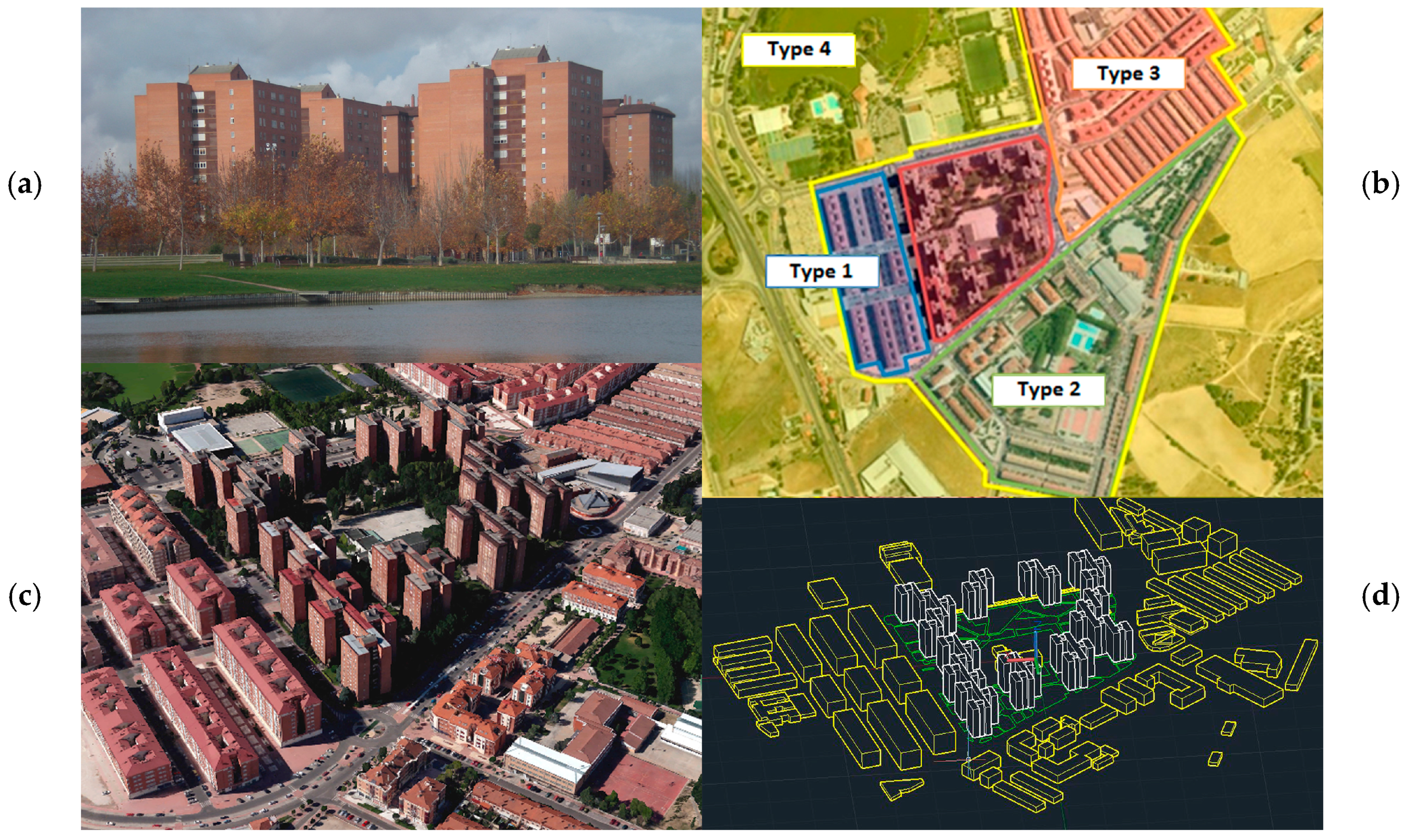
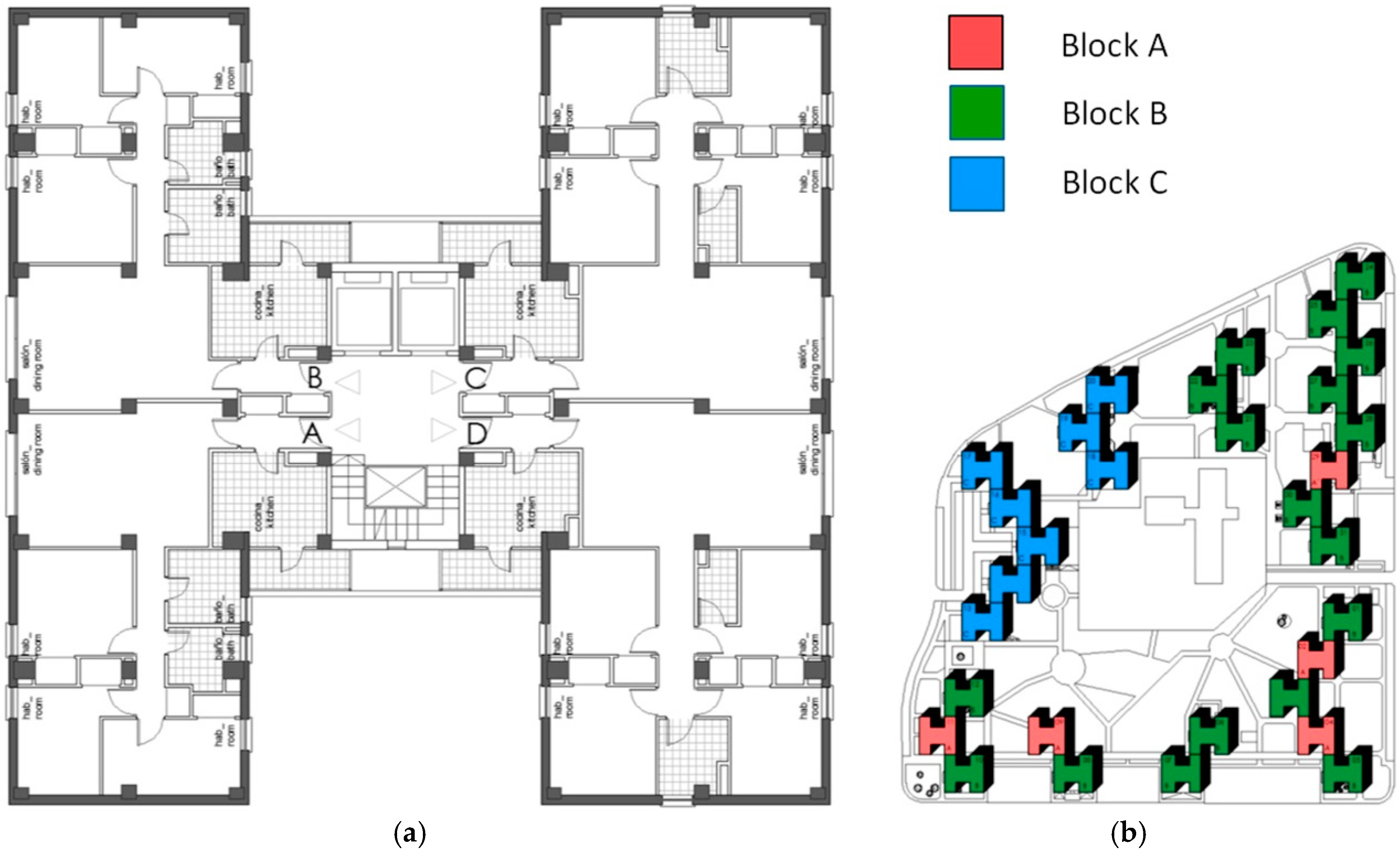


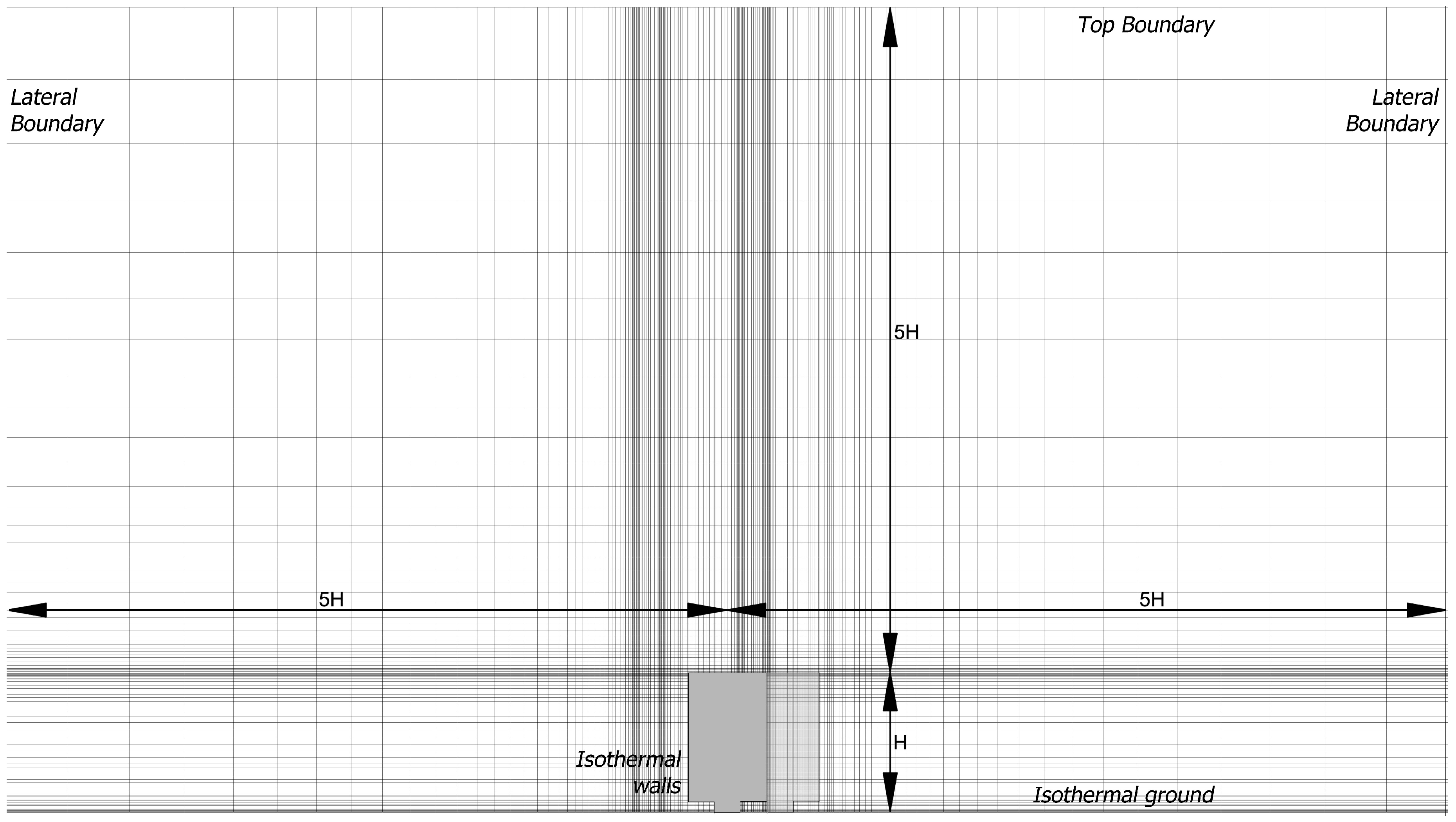
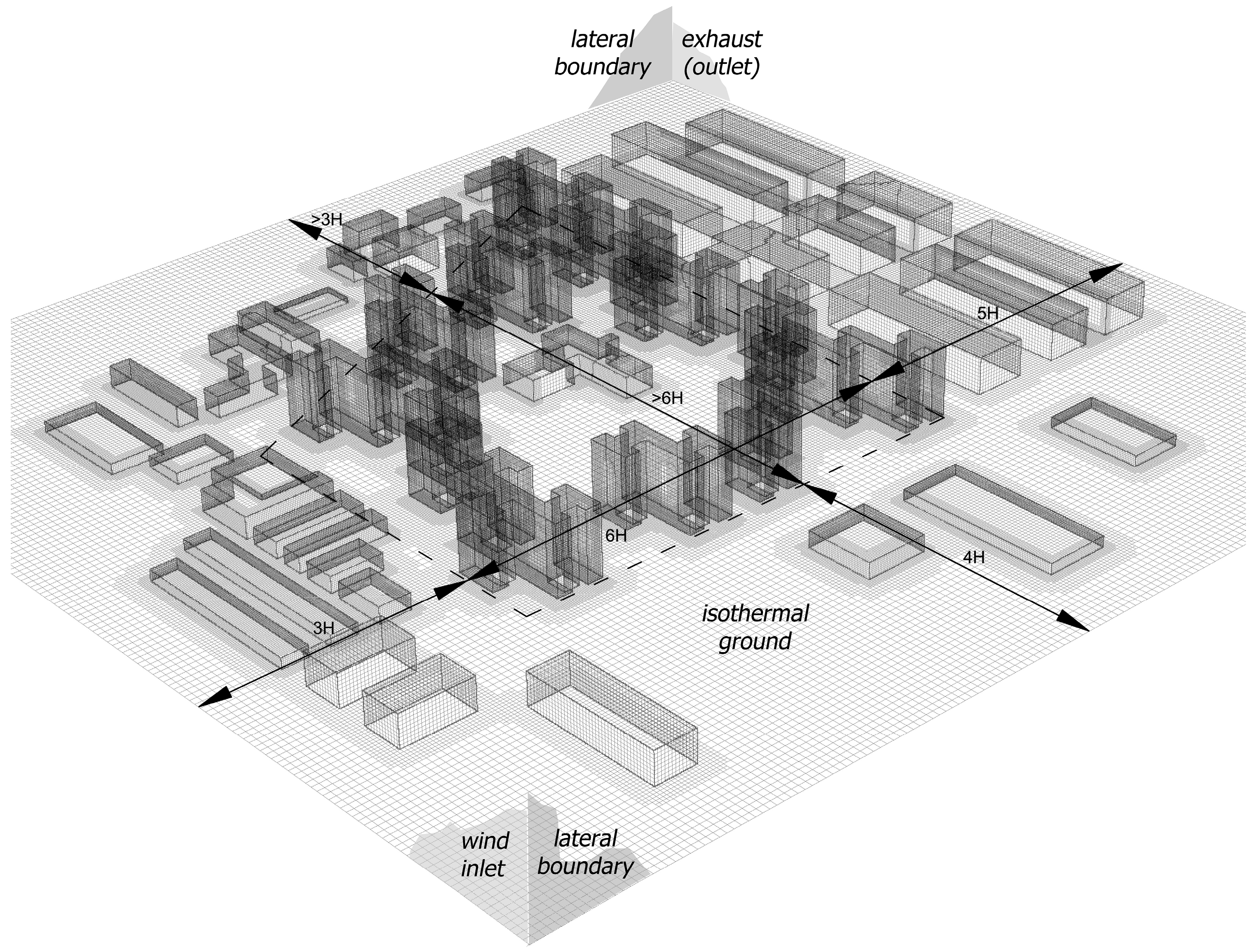

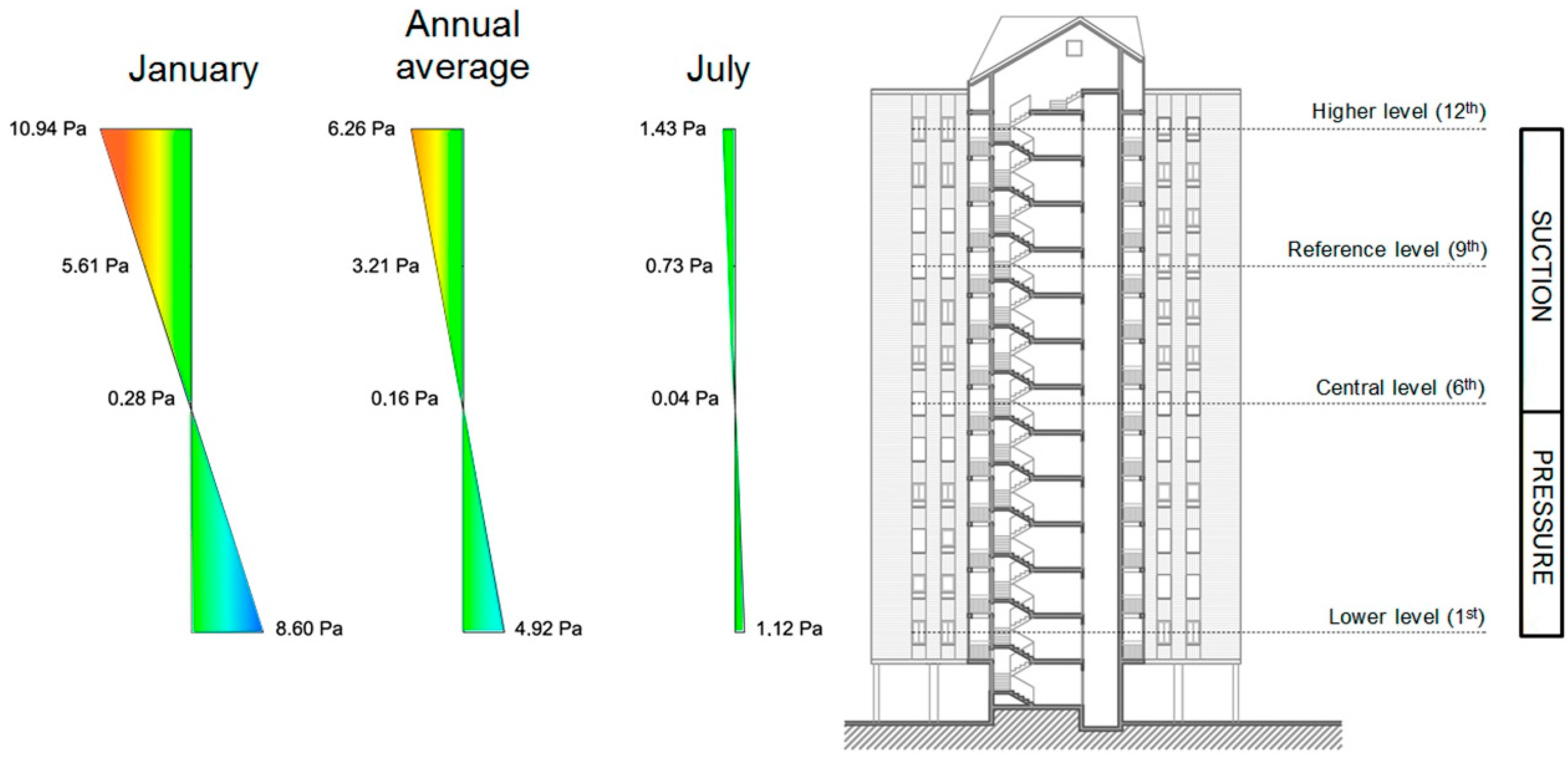

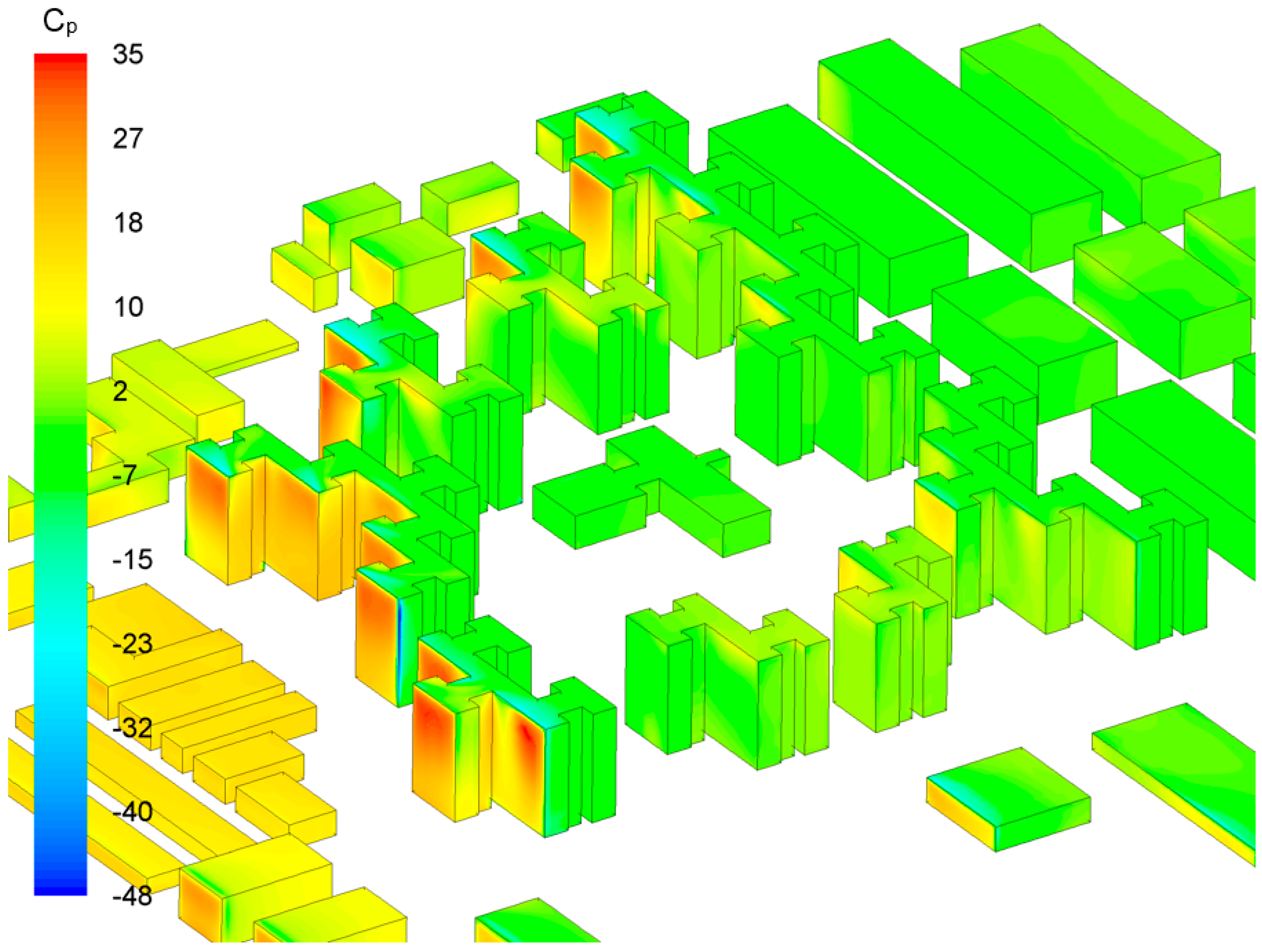
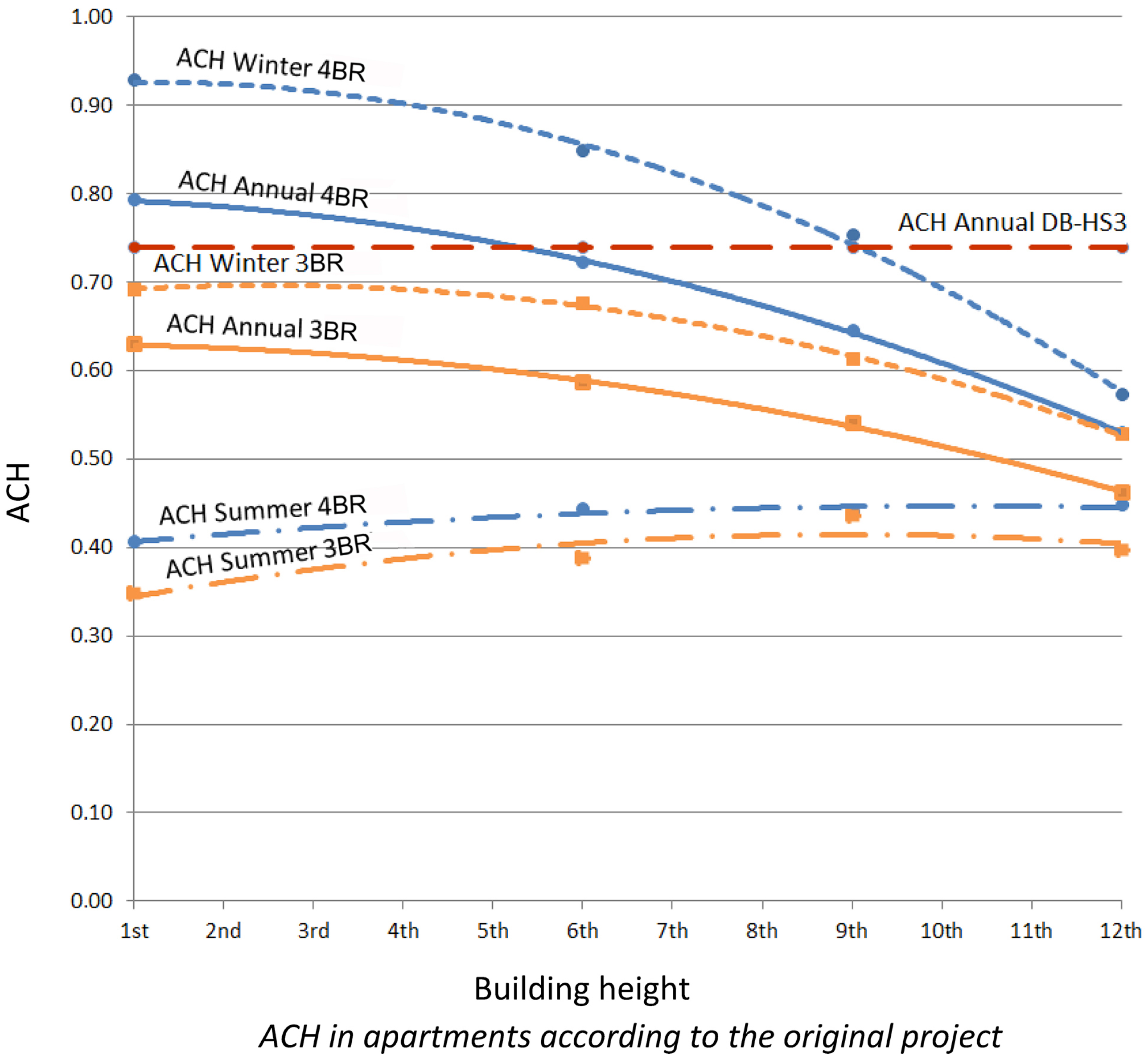
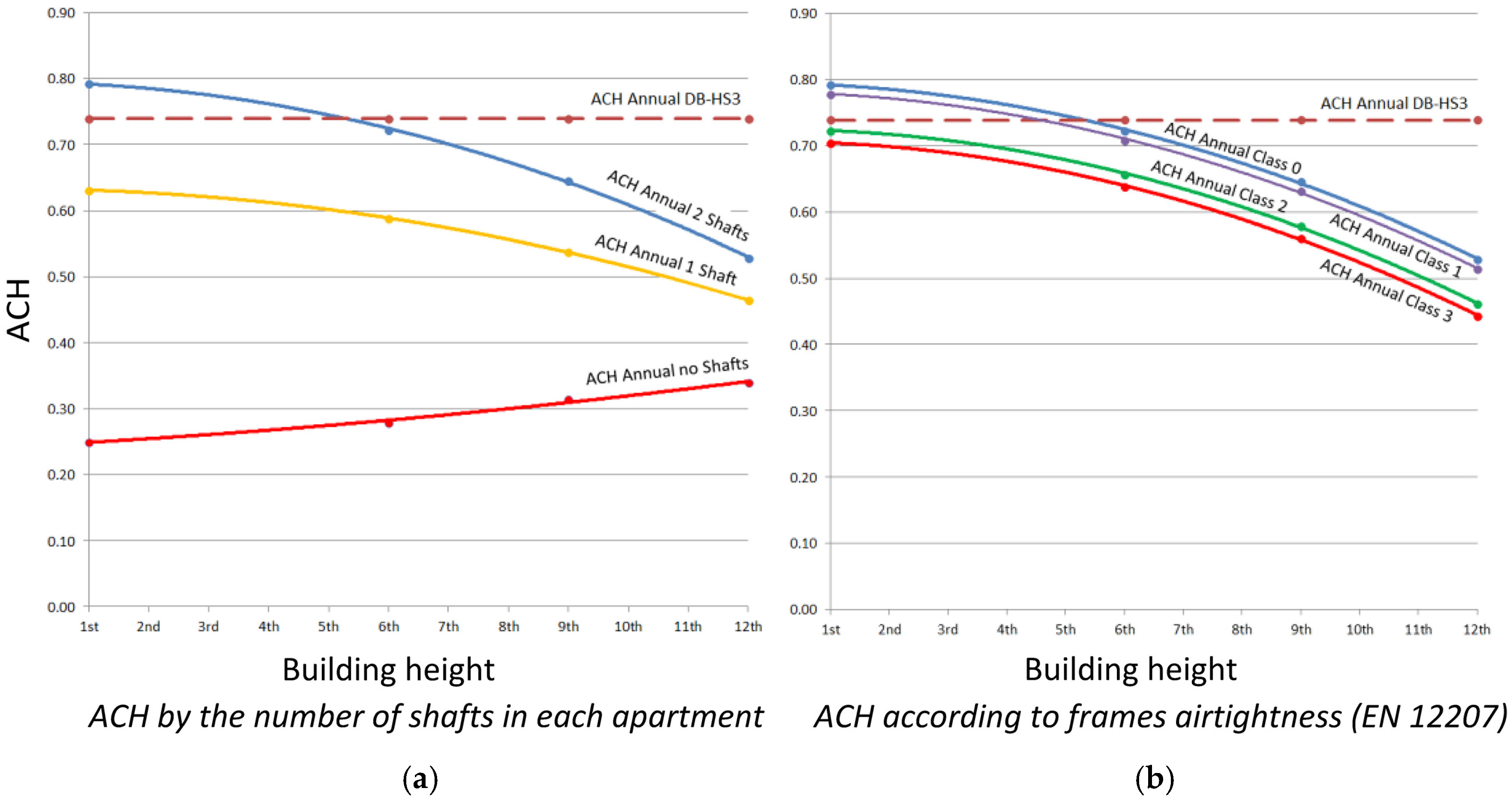
| Air Characteristics (Fluid) | Inlet (Boundary Conditions) | ||||
| air density | 1.204 | kg/m³ | reference wind velocity | 3.000 | m/s |
| mean average temperature (Valladolid) | 293.751 | K | reference height | 100.000 | m |
| - | - | - | turbulent kinetic energy | Equations (3) and (4) | |
| Reynolds number | 37250 | - | turbulent dissipation | Equations (5) and (6) | |
| kinematic viscosity | 1.515 × 10−5 | m²/s | turbulence height | 64.000 | m |
| dynamic viscosity | 1.825 × 10−5 | N·s/m² | von Karman constant (Κ) | 0.410 | - |
| Walls (Boundary Conditions) | Isothermal Ground (Boundary Conditions) | ||||
| roughness height | 0.000 | m | exponential law | 0.220 | - |
| displacement height | 0.000 | m | friction velocity | 0.178 | m/s |
| mean average temperature | 285.65 | K | roughness height | 0.100 | m |
| upper and lateral walls defined with symmetry boundaries | displacement height | 0.000 | m | ||
| CFD Models | Skε Standard Wall Functions | RNG Standard Wall Functions | RNG Enhanced Wall Treatment | Realizable Enhanced Wall Treatment |
|---|---|---|---|---|
| mean deviation | −14.24% | 2.26% | 16.45% | 17.19% |
| mean deviation (≤2H) | −19.26% | −3.81% | 7.20% | 7.56% |
| local mean deviation | −11.97% | 3.72% | 2.97% | 2.57% |
| Accuracy | RNG SWF | RNG EWT | Realizable EWT |
|---|---|---|---|
| <5% | 15.84% | 2.92% | 12.43% |
| 5–10% | 29.90% | 3.57% | 31.07% |
| 10–20% | 22.57% | 8.12% | 23.82% |
| >20% | 31.69% | 83.39% | 32.69% |
| CFD Method | RNG-Second SWF | RNG-Second EWT | Realizable EWT |
|---|---|---|---|
| Velocity mag. | ±4.57% | ±11.19% | ±3.68% |
| X Velocity | ±3.12% | ±3.12% | ±2.01% |
| Y Velocity | ±7.35% | ±7.35% | ±12.46% |
| Z Velocity | ±9.34% | ±9.35% | ±4.23% |
| Dwelling Level | Enc. | Thermal Effect | Wind Effect | Combined Total | ||||||
|---|---|---|---|---|---|---|---|---|---|---|
| Winter | Summer | Annual | Winter | Summer | Annual | Winter | Summer | Annual | ||
| WINDWARD FAÇADE | ||||||||||
| 1st (lower) | α | 8.60 Pa | 1.12 Pa | 4.92 Pa | 7.28 Pa | 5.32 Pa | 7.83 Pa | 15.88 Pa | 6.44 Pa | 12.95 Pa |
| β | 3.12 Pa | 2.29 Pa | 2.76 Pa | 11.72 Pa | 3.41 Pa | 7.68 Pa | ||||
| γ | 4.87 Pa | 3.56 Pa | 6.22 Pa | 13.47 Pa | 4.68 Pa | 11.14 Pa | ||||
| δ | 4.84 Pa | 3.54 Pa | 6.10 Pa | 13.44 Pa | 4.66 Pa | 11.02 Pa | ||||
| 6th (central) | α | 0.28 Pa | 0.04 Pa | 0.16 Pa | 9.72 Pa | 7.14 Pa | 9.26 Pa | 10.00 Pa | 7.18 Pa | 9.42 Pa |
| β | 1.56 Pa | 1.16 Pa | 2.26 Pa | 1.84 Pa | 1.20 Pa | 2.42 Pa | ||||
| γ | 5.16 Pa | 3.76 Pa | 6.97 Pa | 5.44 Pa | 3.80 Pa | 7.13 Pa | ||||
| δ | 5.39 Pa | 3.93 Pa | 6.87 Pa | 5.67 Pa | 3.97 Pa | 7.03 Pa | ||||
| 9th (reference) | α | −5.61 Pa | 0.73 Pa | −3.21 Pa | 10.90 Pa | 8.05 Pa | 9.91 Pa | 5.29 Pa | 8.78 Pa | 6.70 Pa |
| β | 0.60 Pa | 0.45 Pa | 1.72 Pa | −5.01 Pa | 1.18 Pa | −1.49 Pa | ||||
| γ | 5.12 Pa | 3.72 Pa | 6.74 Pa | −0.49 Pa | 4.45 Pa | 3.73 Pa | ||||
| δ | 5.55 Pa | 4.03 Pa | 6.94 Pa | −0.06 Pa | 4.76 Pa | 3.73 Pa | ||||
| 12th (higher) | α | −10.94 Pa | 1.43 Pa | −6.26 Pa | 11.64 Pa | 5.58 Pa | 10.20 Pa | 0.70 Pa | 7,01 Pa | 3.94 Pa |
| β | −0.02 Pa | −0.03 Pa | 1.21 Pa | −10.96 Pa | 1.40 Pa | −5.05 Pa | ||||
| γ | 4.81 Pa | 3.48 Pa | 6.67 Pa | −6.13 Pa | 4.91 Pa | 0.41 Pa | ||||
| δ | 5.29 Pa | 3.83 Pa | 6.89 Pa | −5.65 Pa | 5.26 Pa | 0.63 Pa | ||||
| Roof | −10.94 Pa | 1.43 Pa | −6.26 Pa | −2.36 Pa | −1.77 Pa | −0.66 Pa | −13.30 Pa | −0.34 Pa | −6.92 Pa | |
| LEEWARD FAÇADE | ||||||||||
| 1st (lower) | α | 8.60 Pa | 1.12 Pa | 4.92 Pa | −3.19 Pa | −3.71 Pa | −2.85 Pa | 5.41 Pa | −2.59 Pa | 2.07 Pa |
| β | −4.50 Pa | −5.65 Pa | −3.95 Pa | 4.10 Pa | −4.53 Pa | 0.97 Pa | ||||
| γ | −4.14 Pa | −5.42 Pa | −3.69 Pa | 4.46 Pa | −4.30 Pa | 1.23 Pa | ||||
| δ | −4.21 Pa | −5.43 Pa | −3.80 Pa | 4.39 Pa | −4.31 Pa | 1.12 Pa | ||||
| 6th (central) | α | 0.28 Pa | 0.04 Pa | 0.16 Pa | −3.41 Pa | −3.82 Pa | −3.04 Pa | −3.13 Pa | −3.78 Pa | −2.88 Pa |
| β | −4.41 Pa | −5.67 Pa | −3.98 Pa | −4.13 Pa | −5.63 Pa | −3.82 Pa | ||||
| γ | −4.18 Pa | −5.32 Pa | −3.78 Pa | −3.90 Pa | −5.28 Pa | −3.62 Pa | ||||
| δ | −4.18 Pa | −5.31 Pa | −3.77 Pa | −3.90 Pa | −5.27 Pa | −3.61 Pa | ||||
| 9th (reference) | α | −5.61 Pa | 0.73 Pa | −3.21 Pa | −3.39 Pa | −3.85 Pa | −3.04 Pa | −9.00 Pa | −3.12 Pa | −6.25 Pa |
| β | −4.38 Pa | −5.69 Pa | −3.96 Pa | −9.99 Pa | −4.96 Pa | −7.17 Pa | ||||
| γ | −4.17 Pa | −5.32 Pa | −3.77 Pa | −9.78 Pa | −4.59 Pa | −6.98 Pa | ||||
| δ | −4.16 Pa | −5.31 Pa | −3.76 Pa | −9.77 Pa | −4.58 Pa | −6.97 Pa | ||||
| 12th (higher) | α | −10.94 Pa | 1.43 Pa | −6.26 Pa | −3.33 Pa | −3.99 Pa | −3.01 Pa | −14.27 Pa | −2.56 Pa | −9.27 Pa |
| β | −4.39 Pa | −5.67 Pa | −3.96 Pa | −15.33 Pa | −4.24 Pa | −10.22 Pa | ||||
| γ | −4.19 Pa | −5.53 Pa | −3.78 Pa | −15.13 Pa | −4.10 Pa | −10.04 Pa | ||||
| δ | −4.17 Pa | −5.53 Pa | −3.77 Pa | −15.11 Pa | −4.10 Pa | −10.03 Pa | ||||
| Roof | −10.94 Pa | 1.43 Pa | −6.26 Pa | −4.44 Pa | −3.53 Pa | −4.01 Pa | −15.38 Pa | −2.10 Pa | −10.27 Pa | |
| Apartment | Rate n50 (1/h) | Exponent n | Permeability to air of framed openings at 100 Pa (m3/h·m2) | Presence of Natural Intake in the Shunt | NOTES |
|---|---|---|---|---|---|
| Block 9 Floor12D | 2.8 | 0.61 | 3.0 (Class 3) | Yes (Kitchen and Bathroom) | Substitution for folding PVC frames and double paned glass. Partial retrofit of the opaque enclosure. |
| Block 25 Floor 9C | 6.2 | 0.64 | 48.6 (Class 0) | Yes (Kitchen and Bathroom) | Apartment without modifications according to the original project (aluminium sliding windows with double leaf and single pane). |
| Block 6 Floor 6D | 3.2 | 0.64 | 8.6 (Class 2) | No | Substitution for folding PVC frames and double paned glass. Partial retrofit of the opaque enclosure. |
| Block 4 Floor 1D | 3.8 | 0.66 | 15.0 (Class 1) | Yes (Kitchen) No (Bathroom) | Substitution for Aluminium horizontal sliding sash frames. |
 | Estimated Flow Rate (m3/h) | ACH | Requirement in the DB-HS3 (1/h) | ||||
|---|---|---|---|---|---|---|---|
| Apartment Building | Winter | Summer | Annual | Winter | Summer | Annual | |
| Floor 12-4BR | 125.02 | 97.59 | 115.42 | 0.57 | 0.45 | 0.53 | ≥0.74 |
| Floor 9-4BR | 164.20 | 97.18 | 140.85 | 0.75 | 0.44 | 0.65 | |
| Floor 6-4BR | 185.10 | 96.68 | 157.67 | 0.85 | 0.44 | 0.72 | |
| Floor 1-4BR | 202.50 | 88.49 | 172.83 | 0.93 | 0.41 | 0.79 | |
| Floor 12-3BR | 115.26 | 86.52 | 100.83 | 0.53 | 0.40 | 0.46 | ≥0.74 |
| Floor 9-3BR | 133.67 | 95.16 | 116.70 | 0.61 | 0.44 | 0.54 | |
| Floor 6-3BR | 147.60 | 84.58 | 127.90 | 0.68 | 0.39 | 0.59 | |
| Floor 1-3BR | 150.90 | 75.88 | 137.30 | 0.69 | 0.35 | 0.63 | |
© 2017 by the authors. Licensee MDPI, Basel, Switzerland. This article is an open access article distributed under the terms and conditions of the Creative Commons Attribution (CC BY) license (http://creativecommons.org/licenses/by/4.0/).
Share and Cite
Meiss, A.; Padilla-Marcos, M.A.; Feijó-Muñoz, J. Methodology Applied to the Evaluation of Natural Ventilation in Residential Building Retrofits: A Case Study. Energies 2017, 10, 456. https://doi.org/10.3390/en10040456
Meiss A, Padilla-Marcos MA, Feijó-Muñoz J. Methodology Applied to the Evaluation of Natural Ventilation in Residential Building Retrofits: A Case Study. Energies. 2017; 10(4):456. https://doi.org/10.3390/en10040456
Chicago/Turabian StyleMeiss, Alberto, Miguel A. Padilla-Marcos, and Jesús Feijó-Muñoz. 2017. "Methodology Applied to the Evaluation of Natural Ventilation in Residential Building Retrofits: A Case Study" Energies 10, no. 4: 456. https://doi.org/10.3390/en10040456






